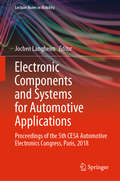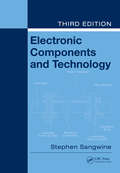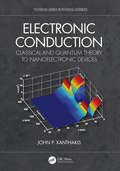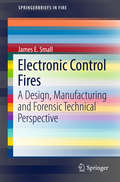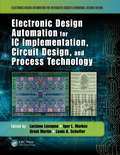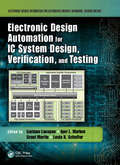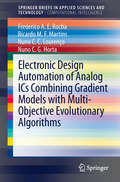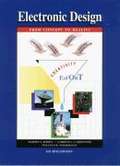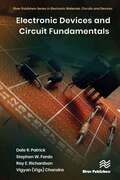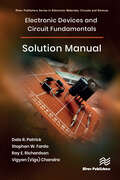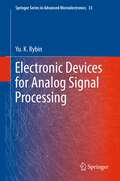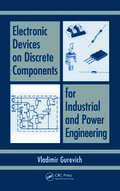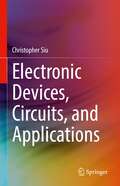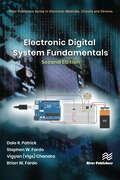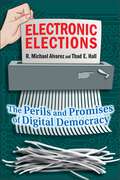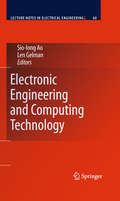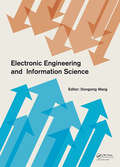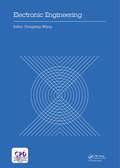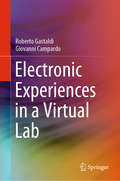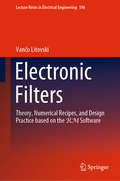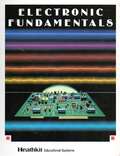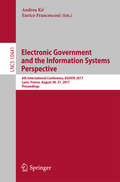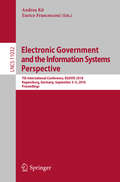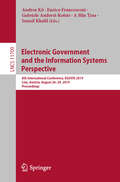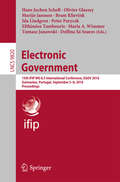- Table View
- List View
Electronic Components and Systems for Automotive Applications: Proceedings of the 5th CESA Automotive Electronics Congress, Paris, 2018 (Lecture Notes in Mobility)
by Jochen LangheimThis volume collects selected papers of the 5th CESA Automotive Electronics Congress, Paris, 2018. CESA is the most important automotive electronics conference in France. The topical focus lies on state-of-the-art automotive electronics with respect to energy consumption and autonomous driving. The target audience primarily comprises industry leaders and research experts in the automotive industry.
Electronic Components and Technology
by Stephen SangwineMost introductory textbooks in electronics focus on the theory while leaving the practical aspects to be covered in laboratory courses. However, the sooner such matters are introduced, the better able students will be to include such important concerns as parasitic effects and reliability at the very earliest stages of design. This philosophy has kept Electronic Components and Technology thriving for two decades, and this completely updated third edition continues the approach with a more international outlook.Not only does this textbook introduce the properties, behavior, fabrication, and use of electronic components, it also helps students grasp and apply sound engineering practice by incorporating in-depth discussions on topics such as safety and reliability. The author employs a holistic treatment that clearly demonstrates how electronic components and subsystems work together, reinforcing the concepts with numerous examples, case studies, problems, illustrations, and objectives. This edition was updated to reflect advances and changes to industrial practice, including packaging technologies, digital oscilloscopes, lead-free solders, and new battery technologies. Additionally, the text's scope now extends to include terminology and standards used worldwide.Including coverage of topics often ignored in other textbooks on the subject, Electronic Components and Technology, Third Edition encourages students to be better, more thoughtful designers and prepares them with current industrial practices.
Electronic Conduction: Classical and Quantum Theory to Nanoelectronic Devices (Textbook Series in Physical Sciences)
by John P. XanthakisElectronic Conduction: Classical and Quantum Theory to Nanoelectronic Devices provides a concise, complete introduction to the fundamental principles of electronic conduction in microelectronic and nanoelectronic devices, with an emphasis on integrating the quantum aspects of conduction. The chapter coverage begins by presenting the classical theory of conduction, including introductory chapters on quantum mechanics and the solid state, then moving to a complete presentation of essential theory for understanding modern electronic devices. The author’s unique approach is applicable to microscale and nanoscale device simulation, which is particularly timely given the explosion in the nanoelectronics field. Features Self-contained Gives a complete account of classical and quantum aspects of conduction in nanometer scale devices Emphasises core principles, the book can be useful to electrical engineers and material scientists, and no prior course in semiconductors is necessary Highlights the bridge to modern electronics, first presenting the physics, and then the engineering complications related to quantum behaviour Includes many clear, illustrative diagrams and chapter problem sets Gives an account of post-Silicon devices such as the GaAs MOSFET, the CNT-FET and the vacuum transistor Showcases why quantum mechanics is necessary with modern devices due to their size and corresponding electron transport properties Discusses all the issues that will enable readers to conduct their own research
Electronic Control Fires
by James E. SmallThe failures of electronic controls, which can cause loss of life and property, are discussed from the perspective of both the design and manufacturing functions and clarified for the responsible forensic team. Many pitfalls of the fast-paced product introduction environment for industrial and consumer products are discussed to help minimize the number of electronic control fires and other menacing events of today. The author clearly links the design, manufacturing and forensic technical communities in the development of electronic control devices, which include a wide array of products, from auto key fobs to furnace electronic control boards. The information included ensures a final product that will not end up in litigation (or at least not be found guilty during litigation), putting into plain words how to determine if a suspect electronic appliance control is the cause of a fire or the result of a fire. Containing invaluable data learned through many years of new product designs, development and production cycles, this brief features illustrated bench experiments conducted by the author. Professionals and researchers working in fire protection, electrical engineering, or building safety will find this brief an essential resource.
Electronic Design Automation for IC Implementation, Circuit Design, and Process Technology: Circuit Design, And Process Technology (Electronic Design Automation For Integrated Circuits Hdbk Ser.)
by Grant Martin Igor L. Markov Luciano Lavagno Louis K. SchefferThe second of two volumes in the Electronic Design Automation for Integrated Circuits Handbook, Second Edition, Electronic Design Automation for IC Implementation, Circuit Design, and Process Technology thoroughly examines real-time logic (RTL) to GDSII (a file format used to transfer data of semiconductor physical layout) design flow, analog/mixed signal design, physical verification, and technology computer-aided design (TCAD). Chapters contributed by leading experts authoritatively discuss design for manufacturability (DFM) at the nanoscale, power supply network design and analysis, design modeling, and much more. New to This Edition: Major updates appearing in the initial phases of the design flow, where the level of abstraction keeps rising to support more functionality with lower non-recurring engineering (NRE) costs Significant revisions reflected in the final phases of the design flow, where the complexity due to smaller and smaller geometries is compounded by the slow progress of shorter wavelength lithography New coverage of cutting-edge applications and approaches realized in the decade since publication of the previous edition—these are illustrated by new chapters on 3D circuit integration and clock design Offering improved depth and modernity, Electronic Design Automation for IC Implementation, Circuit Design, and Process Technology provides a valuable, state-of-the-art reference for electronic design automation (EDA) students, researchers, and professionals.
Electronic Design Automation for IC System Design, Verification, and Testing (Electronic Design Automation For Integrated Circuits Hdbk Ser.)
by Luciano Lavagno, Igor L. Markov, Grant Martin and Louis K. SchefferThe first of two volumes in the Electronic Design Automation for Integrated Circuits Handbook, Second Edition, Electronic Design Automation for IC System Design, Verification, and Testing thoroughly examines system-level design, microarchitectural design, logic verification, and testing. Chapters contributed by leading experts authoritatively discuss processor modeling and design tools, using performance metrics to select microprocessor cores for integrated circuit (IC) designs, design and verification languages, digital simulation, hardware acceleration and emulation, and much more. New to This Edition: Major updates appearing in the initial phases of the design flow, where the level of abstraction keeps rising to support more functionality with lower non-recurring engineering (NRE) costs Significant revisions reflected in the final phases of the design flow, where the complexity due to smaller and smaller geometries is compounded by the slow progress of shorter wavelength lithography New coverage of cutting-edge applications and approaches realized in the decade since publication of the previous edition—these are illustrated by new chapters on high-level synthesis, system-on-chip (SoC) block-based design, and back-annotating system-level models Offering improved depth and modernity, Electronic Design Automation for IC System Design, Verification, and Testing provides a valuable, state-of-the-art reference for electronic design automation (EDA) students, researchers, and professionals.
Electronic Design Automation of Analog ICs combining Gradient Models with Multi-Objective Evolutionary Algorithms
by Nuno C.G. Horta Frederico A.E. Rocha Ricardo M.F. Martins Nuno C.C. LourençoThis book applies to the scientific area of electronic design automation (EDA) and addresses the automatic sizing of analog integrated circuits (ICs). Particularly, this book presents an approach to enhance a state-of-the-art layout-aware circuit-level optimizer (GENOM-POF), by embedding statistical knowledge from an automatically generated gradient model into the multi-objective multi-constraint optimization kernel based on the NSGA-II algorithm. The results showed allow the designer to explore the different trade-offs of the solution space, both through the achieved device sizes, or the respective layout solutions.
Electronic Design: From Concept to Reality (4th Edition)
by Martin S. Roden Goldon L. Carpenter William R. WiesermanThis volume provides coverage of discrete devices, linear integrated circuits, and digital integrated circuits for use in the core electronics courses in undergraduate programs in electrical engineering.
Electronic Devices and Circuit Fundamentals
by Stephen W. Fardo Dale R. Patrick Ray E. Richardson Vigyan (Vigs) ChandraThis book explores many fundamental topics in a basic and easy-to-understand manner. It, and the accompanying DC-AC Electrical Fundamentals by the same co-authors, have been developed using a classic textbook – Electricity and Electronics: A Survey (5th Edition) by Patrick and Fardo – as a framework. Both new books have been structured using the same basic sequence and organization of the textbook as previous editions. This book has been expanded to 23 chapters, further simplifying content and providing a more comprehensive coverage of fundamental content. The content has been continually updated and revised through new editions and by external reviewers throughout the years. Additional quality checks to ensure technical accuracy, clarity and coverage of content have always been an area of focus. Each edition of the text has been improved through the following features: Improved and updated text content. Improved usage of illustrations and photos. Use of color to add emphasis and clarify content.
Electronic Devices and Circuit Fundamentals, Solution Manual
by Stephen W. Fardo Ray E. Richardson Vigyan (Vigs) Chandra Dale R PatrickDevices and Circuit Fundamentals is:• Chapter Outline• Learning Objectives• Key Terms• Figure List• Chapter Summary• Formulas• Answers to Examples / Self-Exams• Glossary of Terms (defined)
Electronic Devices for Analog Signal Processing
by Yu. K. RybinElectronic Devices for Analog Signal Processing is intended for engineers and post graduates and considers electronic devices applied to process analog signals in instrument making, automation, measurements, and other branches of technology. They perform various transformations of electrical signals: scaling, integration, logarithming, etc. The need in their deeper study is caused, on the one hand, by the extension of the forms of the input signal and increasing accuracy and performance of such devices, and on the other hand, new devices constantly emerge and are already widely used in practice, but no information about them are written in books on electronics. The basic approach of presenting the material in Electronic Devices for Analog Signal Processing can be formulated as follows: the study with help from self-education. While divided into seven chapters, each chapter contains theoretical material, examples of practical problems, questions and tests. The most difficult questions are marked by a diamond and can be given to advanced readers. Paragraphs marked by /// are very important for the understanding of the studied material and together they can serve a brief summary of a section. The text marked by italic indicates new or non-traditional concepts. Calculated examples are indicated by >. The main goal of Electronic Devices for Analog Signal Processing is not only to give some knowledge on modern electronic devices, but also to inspire readers on the more detailed study of these devices, understanding of their operation, ability to analyze circuits, synthesize new devices, and assess the possibilities of their application for solution of particular practical problems.
Electronic Devices on Discrete Components for Industrial and Power Engineering
by Vladimir GurevichIs it possible to design and make automatic devices for industrial and power engineering without microcircuits and microprocessors and without complex power supplies? Electronic Devices on Discrete Components for Industrial and Power Engineering answers the question above with a resounding “Yes!” by describing ten original automatic devices based exclusively on modern discrete components. The book reveals that devices based on high-voltage transistors and thyristors as well as miniature vacuum and high power gas-filled reed switches are actually much simpler to implement and more reliable than traditional devices. By identifying elementary functional modules and the basic working principles of semi-conductor devices, the text allows for the construction of complete automatic devices. It also contains an extensive reference section that includes information on modern high-voltage bipolar, FET and IGBT transistors, thyristors and triacs, as well as reed switches.
Electronic Devices, Circuits, and Applications
by Christopher SiuThis textbook for a one-semester course in Electrical Circuits and Devices is written to be concise, understandable, and applicable. Every new concept is illustrated with numerous examples and figures, in order to facilitate learning. The simple and clear style of presentation is complemented by a spiral and modular approach to the topic. This method supports the learning of those who are new to the field, as well as provides in-depth coverage for those who are more experienced. The author discusses electronic devices using a spiral approach, in which key devices such as diodes and transistors are first covered with simple models that beginning students can easily understand. After the reader has grasped the fundamental concepts, the topics are covered again with greater depth in the latter chapters.
Electronic Digital System Fundamentals (River Publishers Series in Electronic Materials, Circuits and Devices)
by Stephen W. Fardo Dale R. Patrick Brian W. Fardo Vigyan (Vigs) ChandraElectronic Digital Systems Fundamentals, 2nd Edition is an introductory text that provides coverage of the various topics in the field of digital electronics. The key concepts presented in this book are discussed using a simplified approach that greatly enhances learning. The use of mathematics is kept to the very minimum and is discussed clearly through applications and illustrations. Each chapter is organized in a step-by-step progression of concepts and theory. The chapters begin with an introduction, discuss important concepts with the help of numerous illustrations, as well as examples, and conclude with summaries. The overall learning objectives of this book include: Describe the characteristics of a digital electronic system. Explain the operation of digital electronic gate circuits. Demonstrate how gate functions are achieved. Use binary, octal, and hexadecimal counting systems. Use Boolean algebra to define different logic operations. Change a logic diagram into a Boolean expression and a Boolean expression into a logic diagram. Explain how discrete components are utilized in the construction of digital integrated circuits. Discuss how counting, decoding, multiplexing, demultiplexing, and clocks function with logic devices. Change a truth table into a logic expression and a logic expression into a truth table. Identify some of the common functions of digital memory. Explain how arithmetic operations are achieved with digital circuitry. Describe the operation of microcontrollers.
Electronic Elections: The Perils and Promises of Digital Democracy
by R. Michael Alvarez Thad E. HallSince the 2000 presidential election, the United States has been embroiled in debates about electronic voting. Critics say the new technologies invite tampering and fraud. Advocates say they enhance the accuracy of vote counts and make casting ballots easier--and ultimately foster greater political participation. Electronic Elections cuts through the media spin to assess the advantages and risks associated with different ways of casting ballots--and shows how e-voting can be the future of American democracy. Elections by nature are fraught with risk. Michael Alvarez and Thad Hall fully examine the range of past methods and the new technologies that have been created to try to minimize risk and accurately reflect the will of voters. Drawing upon a wealth of new data on how different kinds of electronic voting machines have performed in recent elections nationwide, they evaluate the security issues that have been the subject of so much media attention, and examine the impacts the new computer-based solutions is having on voter participation. Alvarez and Hall explain why the benefits of e-voting can outweigh the challenges, and they argue that media coverage of the new technologies has emphasized their problems while virtually ignoring their enormous potential for empowering more citizens to vote. The authors also offer ways to improve voting technologies and to develop more effective means of implementing and evaluating these systems. Electronic Elections makes a case for how e-voting can work in the United States, showing why making it work right is essential to the future vibrancy of the democratic process.
Electronic Engineering and Computing Technology
by Len GelmanElectronic Engineering and Computing Technology contains sixty-one revised and extended research articles written by prominent researchers participating in the conference. Topics covered include Control Engineering, Network Management, Wireless Networks, Biotechnology, Signal Processing, Computational Intelligence, Computational Statistics, Internet Computing, High Performance Computing, and industrial applications. Electronic Engineering and Computing Technology will offer the state of art of tremendous advances in electronic engineering and computing technology and also serve as an excellent reference work for researchers and graduate students working with/on electronic engineering and computing technology.
Electronic Engineering and Information Science: Proceedings of the International Conference of Electronic Engineering and Information Science 2015 (ICEEIS 2015), January 17-18, 2015, Harbin, China
by Dongxing WangThe International Conference of Electronic Engineering and Information Science 2015 (ICEEIS 2015) was held on January 17-18, 2015, Harbin, China. This proceedings volume assembles papers from various researchers, engineers and educators engaged in the fields of electronic engineering and information science.The papers in this proceedings
Electronic Engineering: Proceedings of the 4th International Conference of Electronic Engineering and Information Science (ICEEIS 2017), January 7-8, 2017, Haikou, P.R. China
by Dongxing WangThe 4th International Conference of Electronic Engineering and Information Science 2017 (ICEEIS2017) was held January 7-8, 2017 in Haikou, P.R. China. This conference was sponsored by the Harbin University of Science and Technology, China. The conference continued the tradition of gathering world-class researchers, engineers and educators engaged in the fields of electronic engineering and information science to meet and present their latest activities. The proceedings contains contributions in the fields of Electronic Engineering, Information Science and Information Technologies, Computational Mathematics and Data Mining, Mechatronics, Control and Automation and Material Science and Technologies of Processing.
Electronic Experiences in a Virtual Lab
by Giovanni Campardo Roberto GastaldiThis book presents a collection of “lessons” on various topics commonly encountered in electronic circuit design, including some basic circuits and some complex electronic circuits, which it uses as vehicles to explain the basic circuits they are composed of. The circuits considered include a linear amplifier, oscillators, counters, a digital clock, power supplies, a heartbeat detector, a sound equalizer, an audio power amplifier and a radio. The theoretical analysis has been deliberately kept to a minimum, in order to dedicate more time to a “learning by doing” approach, which, after a brief review of the theory, readers are encouraged to use directly with a simulator tool to examine the operation of circuits in a “virtual laboratory.” Though the book is not a theory textbook, readers should be familiar with the basic principles of electronic design, and with spice-like simulation tools. To help with the latter aspect, one chapter is dedicated to the basic functions and commands of the OrCad P-spice simulator used for the experiments described in the book.
Electronic Filters: Theory, Numerical Recipes, and Design Practice based on the RM Software (Lecture Notes in Electrical Engineering #596)
by Vančo LitovskiThis book provides a comprehensive overview of signal filtering, including an introduction, definitions of the terms and algorithms for numerical calculation of the properties of the transfer function in frequency and time domains. All the chapters discuss the theoretical background and explain the underlying algorithms including the iterative numerical procedures necessary to obtain the solutions. It starts by considering polynomial filters, offering a broad range of solutions and introducing critical monotonic passband amplitude characteristics (CMAC). It also describes modifications to the classical Chebyshev and elliptic filters to overcome their limitations. In the context linear phase low-pass prototypes, it presents filters approximating constant group delay in the equi-ripple manner for the first time. Further, it discusses new procedures to improve the selectivity of all polynomial filters by introducing transmission zeros, such as filters with multiple transmission zeros on the omega axis, as well as phase correction of selective filters for both low-pass and band-pass filters. Other topics explored include linear phase all-pass (exhibiting low-pass group delay approximation) filters; all-pass filters (exhibiting band-pass group delay approximation) with linear and parabolic phase synthesized directly as band-pass; high-pass, and band-stop amplitude characteristic frequency transformations to produce band-pass; and direct synthesis of linear and parabolic phase selective band-pass filters synthesized directly as band-pass. Lastly, for system (physical) synthesis, the book describes the algorithms and procedures for the following: cascade passive LC; active cascade RC; active parallel RC (for the first time); active parallel SC; Gm-C based on LC prototypes; and parallel IIR based on bilinear transformation of analog prototypes. Every algorithm, be it in transfer function synthesis or in system synthesis, is accompanied by a proper nontrivial comprehensive example produced by the RM software.
Electronic Government and the Information Systems Perspective: 6th International Conference, EGOVIS 2017, Lyon, France, August 28-31, 2017, Proceedings (Lecture Notes in Computer Science #10441)
by Enrico Francesconi Andrea KőThis book constitutes the refereed proceedings of the 6th International Conference on Electronic Government and the Information Systems Perspective, EGOVIS 2017, held in Lyon, France, in August 2017. The 20 revised full papers presented were carefully reviewed and selected from 24 submissions. The papers areorganized in the following topical sections: digitalization and transparency; open data ecosystems; intelligent systems in e-government; e-government research and intelligent systems; m-government and inclusion; e-government cases - data knowledge management; and knowledge management in the context of e-government.
Electronic Government and the Information Systems Perspective: 7th International Conference, EGOVIS 2018, Regensburg, Germany, September 3–5, 2018, Proceedings (Lecture Notes in Computer Science #11032)
by Enrico Francesconi Andrea KőThis book constitutes the refereed proceedings of the 7th International Conference on Electronic Government and the Information Systems Perspective, EGOVIS 2018, held in Regensburg, Germany, in September 2018. The 19 revised full papers presented were carefully reviewed and selected from 22 submissions. The papers are organized in the following topical sections: digitalization and transparency; challenges in e-government technology and e-voting; knowledge management in the context of e-government; semantic technologies and the legal aspects; open data and open innovation; and e-government cases - data and knowledge management.
Electronic Government and the Information Systems Perspective: 8th International Conference, EGOVIS 2019, Linz, Austria, August 26–29, 2019, Proceedings (Lecture Notes in Computer Science #11709)
by Enrico Francesconi Andrea Kő Ismail Khalil A Min Tjoa Gabriele Anderst-KotsisThis book constitutes the refereed proceedings of the 8th International Conference on Electronic Government and the Information Systems Perspective, EGOVIS 2019, held in Linz, Austria, in August 2019. The 17 full papers presented were carefully reviewed and selected from 25 submissions. The papers are organized in the following topical sections: open data and open innovation; data-driven approaches in e-government; e-government cases – data and knowledge management; e-government theoretical background; and digitalization and transparency.
Electronic Government: 15th IFIP WG 8.5 International Conference, EGOV 2016, Guimarães, Portugal, September 5-8, 2016, Proceedings (Lecture Notes in Computer Science #9820)
by Efthimios Tambouris Maria A. Wimmer Delfina Sá Soares Tomasz Janowski Hans Jochen Scholl Marijn Janssen Bram Klievink Ida Lindgren Peter Parycek Olivier GlasseyThis book constitutes the refereed proceedings of the 15th IFIP WG 8.5 International Conference on Electronic Government, EGOV 2016, held in Guimaraes, Portugal, in September 2016, in conjunction with the 8th International Conference on eParticipation, ePart 2016. The 24 revised full papers presented were carefully reviewed and selected from 87 submissions. The papers are clustered under the following topical sections: foundations; benchmarking and evaluation; information integration and governance; services; evaluation and public values; EGOV success and failure; governance; social media; engagement; processes; policy-making; trust, transparency and accountability; open government and big/open data; smart government/governance/cities.
